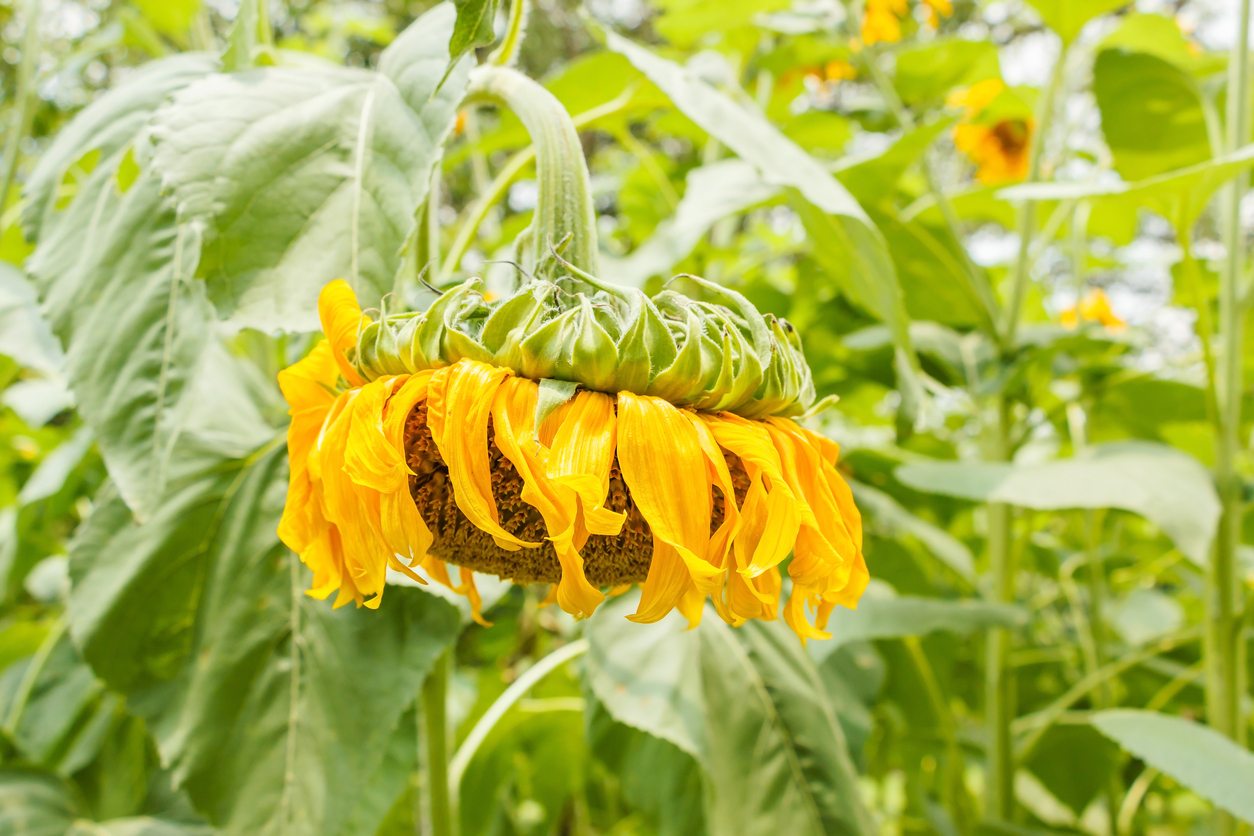Fixing Drooping Sunflowers: How To Keep Sunflowers From Drooping

Sunflowers make me happy; they just do. They are easy to grow and pop up cheerfully and unbidden beneath the bird feeders or anywhere they’ve been grown before. They do, however, have a tendency to droop. The question is: why do my sunflowers droop over and what can I do about drooping sunflowers?
Why Do My Sunflowers Droop Over?
Drooping in sunflower plants can occur in both young and older plants. What to do about drooping sunflowers depends on what stage of growth they’re in and the cause of the drooping.
Sunflower droop in young plants
Diseases and pests can cause sunflowers to droop, as can transplant shock. Sunflowers do best when they are seeded directly outside. Living in a cooler climate, I have started them indoors before and then transplanted them outside. Transplanting them disturbs the roots, which puts the plant into shock mode. If you must start the seeds inside for later transplant, start them in peat pots. When you go to transplant them, tear off the top ½ inch (1.25 cm.) of the peat pot so it doesn’t wick away moisture. Also, harden off the seedlings before planting so they can acclimate to the outdoor temperatures. Fungal diseases can cause a number of issues with sunflowers, including damping off. One of the first signs of damping off is wilting or drooping. This is followed by yellowing foliage, stunting and failure to thrive. Proper sowing and watering can decrease the risk of damping off. Sow seeds in warm soil, 2 inches (5 cm.) deep and only water when the top ½ inch (1.25 cm.) of soil is completely dried out. Insects, like caterpillars and spider mites, can damage young sunflower seedlings, causing them to droop, yellow and even die. Keep the area around the seedlings free from debris and weeds that harbor pests. Treat a drooping plant with a mild insecticidal soap if you suspect a pest infestation.
Drooping in mature sunflowers
Some sunflowers can attain great heights with large sunny yellow heads. So an obvious reason for drooping heads is simply top-heavy sunflowers. If this is the case, there’s no fixing drooping sunflowers. Top-heavy sunflowers are a natural occurrence just as overladen fruit boughs bend under the weight of a plentiful harvest. If all else is well with the plant and it is healthy, the stalk should be able to withstand the weight without splitting. If you are truly worried about damage to the stalk, however, tie the head up to a fence, tree, eave, or whatever the sunflower is near to help the plant bear the weight. Another possibility for drooping sunflowers is that the plants need water. An indicator of this is leaves that are wilted as well. Sunflowers, in general, can withstand some drought. But they do best with deep, regular watering to encourage root growth. This is especially beneficial with the taller varieties that need strong roots to hold up the tall stalks and heavy heads.
How to Keep Sunflowers from Drooping
Excellent cultural conditions are the key to keeping sunflowers from drooping. If the plants are in a shaded area or have too much or too little water, you may find them droopy looking. Sow sunflowers in full sun in moderately fertile, well-draining soil. Water them with one inch (2.5 cm.) of water per week depending upon rainfall. Check the soil prior to watering. Allow the top ½ inch (1.25 cm.) of soil to dry between watering, which will help prevent fungal infections. Keep the area around the plants weed and detritus free. Sunflowers don’t usually need fertilizer, but a little boost won’t hurt them. Too much nitrogen, however, will result in healthy green foliage and few blooms. Use a low nitrogen food such as a 5-10-10. Sprinkle the lowest application recommendation on the manufacturer’s label, generally ½ cup (120 mL) per 25 square feet (7.5 square m.). Follow all of the above tips and you won’t be wondering about fixing drooping sunflowers. Unless, of course, the drooping is from top-heavy heads and then really that’s a great thing – more sunflower seeds for you to eat!
Gardening tips, videos, info and more delivered right to your inbox!
Sign up for the Gardening Know How newsletter today and receive a free copy of our e-book "How to Grow Delicious Tomatoes".

Amy Grant has been gardening for 30 years and writing for 15. A professional chef and caterer, Amy's area of expertise is culinary gardening.
-
 Zinnias On Repeat: 10 Glorious Cut-And-Come-Again Varieties For Endless Summer Bouquets
Zinnias On Repeat: 10 Glorious Cut-And-Come-Again Varieties For Endless Summer BouquetsThese zinnia varieties keep giving all summer, making them the perfect choice for dedicated cutting gardens – or just the occasional homegrown bouquet.
By Ellen Wells
-
 Create A Romantic Garden Straight Out Of Bridgerton: Regency Era Romance In Your Garden
Create A Romantic Garden Straight Out Of Bridgerton: Regency Era Romance In Your GardenTry some romantic garden ideas straight out of Bridgerton. Flowers and gardens in the Regency era were lush and charming and you can get the same look!
By Bonnie L. Grant